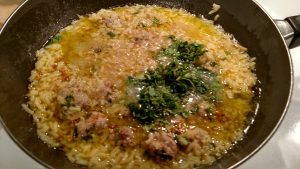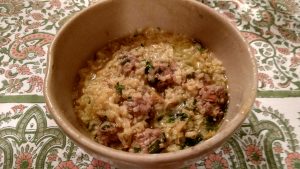One of our favorite dishes is Arroz con Chorizo, or Rice and Sausage. The sausage usually entails chorizo, the Spanish pork sausage most common to Puerto Rican cuisine. But for this dish you can use any preferred sausage be it beef, pork, chicken or turkey. The recipe also calls for sofrito, a common base flavoring in Nuyorican cooking. You can find a recipe for sofrito in our post of 10/16/20. If you don’t have the time or ingredients for sofrito, you can use achiote, as we did in this version. Achiote is easy to make. Just heat ½ cup olive oil in a small skillet or pan. Add 1 tablespoon annatto seeds (found in most supermarkets or Hispanic markets). Cook, stirring frequently on low flame until the oil turns a bright orange-red color. Use as needed, cover and refrigerate. The achiote will give not only flavoring, but also that bright color that defines the rice.
The most common accompaniment to this recipe is beans. It can be red kidney beans, black beans, white beans, ext. This time around we used pinto beans. This is the type of hearty meal that comforts the soul.
Ingredients:
2 cups rice
2 tablespoons olive oil
1 medium onion, peeled and sliced into thin rings
1 clove garlic, peeled and minced
2 chorizos or 4 preferred sausage (about 12-ounce pack), sliced into ¼-inch rounds
1 tablespoon achiote
Water or chicken broth to cover
Salt and ground black pepper to taste
Instructions:
- Wash rice until liquid runs clear. This is what they call in Pennsylvania Dutch country as “washing in several waters” to remove starch from the rice.
- Heat oil over medium heat in a heavy skillet or pot (we prefer cast-iron). Add onion and stir-fry until onion is wilted and translucent. Add garlic and cook for 2 minutes more.
- Add rice. Stir in achiote, and add water to cover contents in pot ¼ to ½ inch. Add salt and pepper.
- Bring to a boil. Cover tightly and simmer on low heat until water is absorbed and rice is tender (about 20-25 minutes). Serve with beans.
Yield: 6 servings.






 Sofrito is ubiquitous in Caribbean cooking. One could safely say that Puerto Rican cuisine would be wanting without it. It is an aromatic mix of herbs and spices that is a base for cooking countless criollo dishes. This concept can be found in other cultures as well. One example is the Indian mix called garam masala which is also used as a base flavoring. Or kimchi, the fermented cabbage condiment, so popular in Korean cooking. The word sofrito is a generic term that has no correct English translation. “Frito” in Spanish means fried. Sofrito could be taken to mean stir-fried. Although this would not be entirely accurate. As the recipe shows, sofrito can be whipped up in a few moments’ time in a blender or food processor. And it can be stored in a closed tight jar the refrigerator for three to four days or, in the freezer compartment, indefinitely.
Sofrito is ubiquitous in Caribbean cooking. One could safely say that Puerto Rican cuisine would be wanting without it. It is an aromatic mix of herbs and spices that is a base for cooking countless criollo dishes. This concept can be found in other cultures as well. One example is the Indian mix called garam masala which is also used as a base flavoring. Or kimchi, the fermented cabbage condiment, so popular in Korean cooking. The word sofrito is a generic term that has no correct English translation. “Frito” in Spanish means fried. Sofrito could be taken to mean stir-fried. Although this would not be entirely accurate. As the recipe shows, sofrito can be whipped up in a few moments’ time in a blender or food processor. And it can be stored in a closed tight jar the refrigerator for three to four days or, in the freezer compartment, indefinitely.



